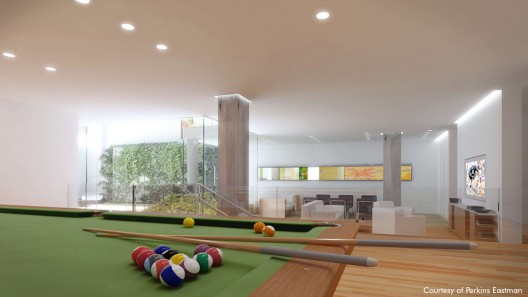
Another proposal for the design of the Taipei Performing Arts Center by Emergent Architecture. Their aim for the design is to create a world-class urban experience defined by hybrid urban environments not traditionally associated with performing arts theaters.
DESIGN CONCEPT: (text from Emergent Architecture)
"The three theaters are woven together by way of an elevated Concourse, creating a unified whole which has significant presence in the city. The Concourse is a bridging element which acts as circulation for the theaters but also as a commercial zone which includes lively urban activities such as shopping, restaurants, bars, and other public amenities. It will be a 24 hour space which will support the theater functions but also operate independently. Below the Concourse is an urban plaza which is defined by ground topography and the exotic underbelly formation of the Concourse. This space is both the orientation space for the theaters, but also a place for urban events, meeting people, or simply passing through.

The morphology of the project is based on patterns of armatures and pleats which form an intricate ornamental network. Armatures are woven together to create the circulation and structure of the Concourse, forming deep spaces and views from the plaza into the building as well as from the building down into the Plaza and out into the city.

Micro-pleats track along the armatures but also spread out along surfaces, spatially drawing visitors inside the Plaza. The sensations produced by this fluid geometry are heightened by a gradient of color which is most intense on the interior but fades out to the exterior of the building. Formal and color intensities are at their peak in the Concourse, and begin to atrophe toward the theater blocks at the perimeter of the site. In this way this project attempts to bridge classifications of generic and articulated form as well as monochromatic and variegated color.

The Concourse contains the shops arranged in a looping, multi-level arrangement. Restaurants, bars, cafes, and forms of entertainment will be complimented by cultural activities such as art galleries, bookstores, and the theater library. The Concourse is therefore not a mall, but a cultural space, an urban extension of the institution of ‘theater’.

Urban Massing Considerations
The massing of the building responds to external forces, in particular the strong attractor of the Shilin Night Market and the adjacency of the TRTS Jiantan train station across Wen Lin Road. In order to facilitate fluid connection to the Shilin Night Market, the building pulls back and lifts up to become a roof. This becomes a strong linking corridor between the Performing Arts Plaza and the pedestrian entry into the market. The entire east side of the building is carved out to allow views to and from the train station in order to establish a critical connection between the two. An underground passage links the train station, the Night Market, and the Performing Arts Plaza into a robust network.

The zoning requirement of 75% maximum lot coverage is attained by adherence to a 10 M. setback from the siteline as well as additional local setbacks of up to 17 M. Our response to the spirit of the zoning law, however, which is intended to allow for green space, is more comprehensive: by lifting the building off the ground in significant areas, we allow are providing at total of 55% open public space at the ground level. This space will be designed to include soft and hardscape, including exotic flowers, trees, and reflecting pools.

The Theaters and Program Description
The Grand Theater is located on the south end of the site, rotated toward Wen Lin Road. It is designed according to the brief as a proscenium type with 1500 seats and two balconies. It contains all the required back-of-house programs as well as a flytower. The Proscenium Playhouse, located to the northwest corner of the site, is also based on the proscenium type, with associated back-of-house programs and 800 seats. The Multiform Theater is located to the northeast corner of the site and has a 500-800 seat capacity. This theater will be flexibly designed so that it can take the form of a thrust stage, theater-in-the-round, or proscenium arrangement. It will have a flat floor to allow for ease of transformation and build-out. Theater interiors are designed based on optimal sightlines as well as acoustics. All three theaters are entered from the Plaza and have their own separate foyers. These foyers are linked to the Concourse, which becomes the ‘linking space’ called for in the brief.

Source: Emergent Architecture
Read more...
 303 East 33rd Street, the first green development in the Murray Hill neighborhood of Manhattan, is designed by top ranked green architecture and design firm Perkins Eastman. The LEED Certified development is a 12-story, 165,00 sf building defined as a series of single attached buildings facing the street alternating in height.
303 East 33rd Street, the first green development in the Murray Hill neighborhood of Manhattan, is designed by top ranked green architecture and design firm Perkins Eastman. The LEED Certified development is a 12-story, 165,00 sf building defined as a series of single attached buildings facing the street alternating in height.





















































